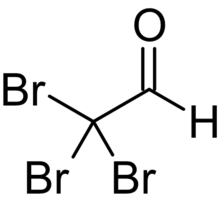
| |
| Names | |
|---|---|
| Other names Tribromoacetaldehyde | |
| Identifiers | |
| CAS Number | |
| 3D model (JSmol) | |
| ChEMBL | |
| ChemSpider | |
| ECHA InfoCard | 100.003.698 |
| EC Number |
|
| PubChem CID | |
| UNII | |
| CompTox Dashboard (EPA) | |
InChI
| |
SMILES
| |
| Properties | |
| Chemical formula | C2HBr3O |
| Molar mass | 280.741 g·mol |
| Appearance | Oily liquid |
| Melting point | −57.5 °C (−71.5 °F; 215.7 K) |
| Boiling point | 174 °C (345 °F; 447 K) |
| Solubility in water | Reacts to form bromal hydrate |
| Hazards | |
| Occupational safety and health (OHS/OSH): | |
| Main hazards | Toxic |
| GHS labelling: | |
| Pictograms |  
|
| Signal word | Danger |
| Hazard statements | H301, H310, H314 |
| Precautionary statements | P260, P262, P264, P270, P280, P301+P316, P301+P330+P331, P302+P352, P302+P361+P354, P304+P340, P305+P354+P338, P316, P321, P330, P361+P364, P363, P405, P501 |
| Lethal dose or concentration (LD, LC): | |
| LD50 (median dose) | 100 mg/kg (rat, oral) 25 mg/kg (mice, oral) |
| Related compounds | |
| Related compounds | Fluoral, Chloral, Iodal |
| Except where otherwise noted, data are given for materials in their standard state (at 25 °C , 100 kPa). Infobox references | |
Bromal (tribromoacetaldehyde) is a brominated aldehyde. It reacts with water to form bromal hydrate.
See also
References
- ^ "Initial Submission: Acute Toxicity Studies of Tribromoacetaldehyde with Cover Letter dated 09/21/92". Environmental Protection Agency, Washington, DC. Office of Toxic. 1992.
- "Tribromoacetaldehyde". pubchem.ncbi.nlm.nih.gov.
- Novak, A.; Whalley, E. (January 1960). "Infrared spectra of fluoral, chloral and bromal hydrates". Spectrochimica Acta. 16 (5): 521–527. Bibcode:1960AcSpe..16..521N. doi:10.1016/0371-1951(60)80008-2.
This article about an organic halide is a stub. You can help Misplaced Pages by expanding it. |